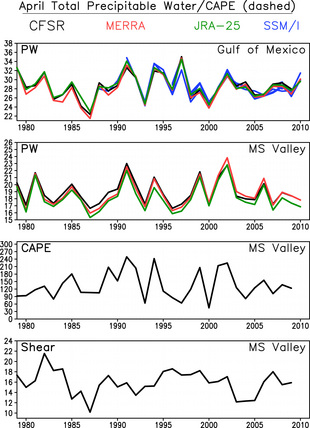NOAA's CSI group led by Marty Hoerling has put out an initial assessment (see also) of the recent tornado outbreak. They conclude:
Our diagnosis attempts to reveal whether large-scale conditions may have become more favorable for violent storms to occur over the lower Mississippi Valley, the region of the recent super tornado outbreak. Various data sets are used to estimate the time variability in column precipitable water (Fig. 1, top 2 panels). These are found to be in close agreement with each other with respect to their interannual variability; the water vapor time series are dominated by strong year-to-year variations both over the Gulf of Mexico (top) source region and over the lower Mississippi Valley impact region of possible tornadic activity (second panel). A similar interpretation applies to a time series of thermodynamic stability (based on the index of convective available potential energy, CAPE) which as might be expected, varies coherently with the atmospheric water vapor content (third panel). Finally, the vector wind shear magnitude for the surface-500mb layer is also dominated by interannual variability, with little evidence for a trend during the 30-yr period (lower panel).The non-technical bottom line?
Neither the time series of thermodynamic nor dynamic variables suggests the presence of a discernable trend during April; any small trend that may exist would be statistically insignificant relative to the intensity of yearly fluctuations. A change in the mean climate properties that are believed to be particularly relevant to severe storms has thus not been detected for April, at least during the last 30 years. Barring a detection of change, a claim of attribution (to human impacts) is thus problematic, although it does not exclude that a future change in such environmental conditions may occur as anthropogenic greenhouse gas forcing increases.
There is at present no indication that the environmental factors conducive to tornado development for this location and time have change over the last 30 years, meaning that no change has been detected. Absent detection, there is no attribution. As NOAA says, maybe there will be one day, but not yet.






0 comments:
Post a Comment